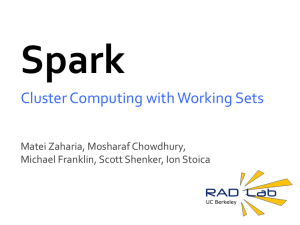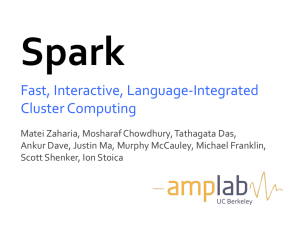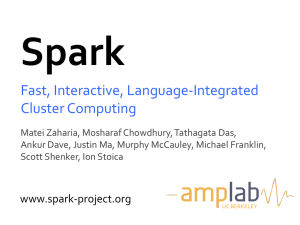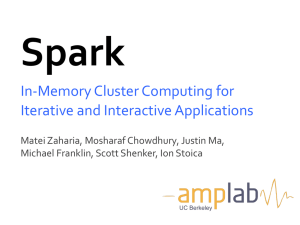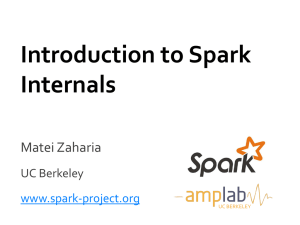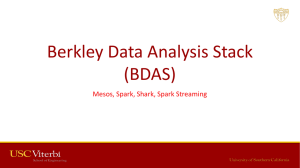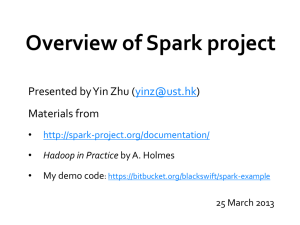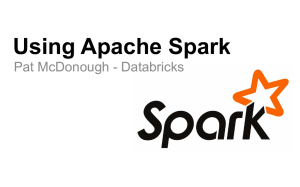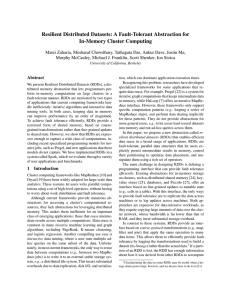Spark
advertisement
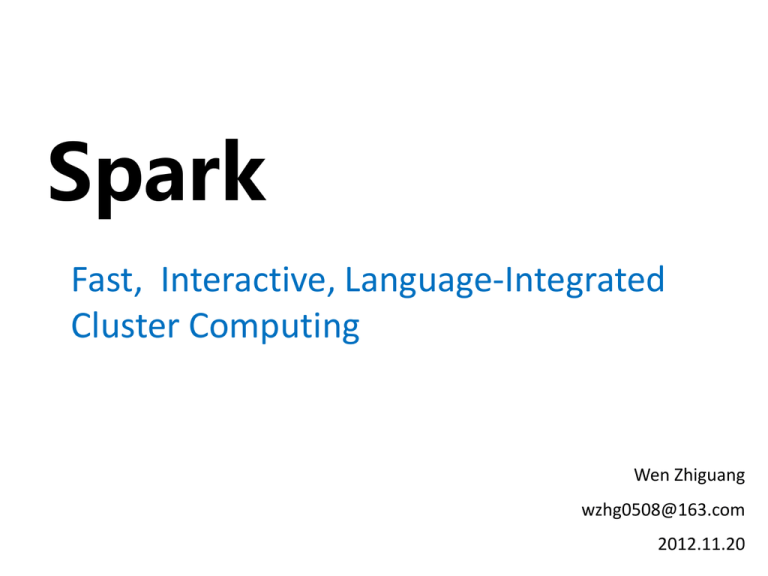
Spark Fast, Interactive, Language-Integrated Cluster Computing Wen Zhiguang wzhg0508@163.com 2012.11.20 Project Goals Extend the MapReduce model to better support two common classes of analytics apps: >> Iterative algorithms (machine learning, graph) >> Interactive data mining Enhance programmability: >> Integrate into Scala programming language >> Allow interactive use from Scala interpreter Background Most current cluster programming models are based on directed acyclic data flow from stable storage to stable storage Benefits of data flow: runtime can decide where to run tasks and can automatically recover from failures Background Acyclic data flow is inefficient for applications that repeatedly reuse a working set of data: >> Iterative algorithms (machine learning, graphs) >> Interactive data mining tools (R, Excel, Python) With current frameworks, apps reload data from stable storage on each query Solution: Resilient Distributed Datasets (RDDs) Allow apps to keep working sets in memory for efficient reuse Retain the attractive properties of MapReduce >> Fault tolerance, data locality, scalability Support a wide range of application Outline • • • • • • Introduction to Scala & functional programming What is Spark Resilient Distributed Datasets (RDDs) Implementation Demo Conclusion About Scala High-level language for JVM >> Object-oriented + Functional programming (FP) Statically typed >> Comparable in speed to Java >> no need to write types due to type inference Interoperates with Java >> Can use any Java class, inherit from it, etc; >> Can also call Scala code from Java Quick Tour Quick Tour All of these leave the list unchanged (List is Immutable) Outline • • • • • • Introduction to Scala & functional programming What is Spark Resilient Distributed Datasets (RDDs) Implementation Demo Conclusion Spark Overview Goal: work with distributed collections as you would with local ones Concept: resilient distributed datasets (RDDs) >> Immutable collections of objects spread across a cluster >> Built through parallel transformations (map, filter, etc) >> Automatically rebuilt on failure >> Controllable persistence (e.g. caching in RAM) for reuse >> Shared variables that can be used in parallel operations Spark framework Spark + Pregel Spark + Hive Run Spark Spark runs as a library in your program (1 instance per app) Runs tasks locally or on Mesos >> new SparkContext ( masterUrl, jobname, [sparkhome], [jars] ) >> MASTER=local[n] ./spark-shell >> MASTER=HOST:PORT ./spark-shell Outline • • • • • • Introduction to Scala & functional programming What is Spark Resilient Distributed Datasets (RDDs) Implementation Demo Conclusion RDD Abstraction An RDD is a read-only , partitioned collection of records Can only be created by : (1) Data in stable storage (2) Other RDDs (transformation , lineage) An RDD has enough information about how it was derived from other datasets(its lineage) Users can control two aspects of RDDs: 1) Persistence (in RAM, reuse) 2) Partitioning (hash, range, [<k, v>]) RDD Types: parallelized collections By calling SparkContext’s parallelize method on an existing Scala collection (a Seq obj) Once created, the distributed dataset can be operated on in parallel RDD Types: Hadoop Datasets Spark supports text files, SequenceFiles, and any other Hadoop inputFormat Local path or hdfs://, s3n://, kfs:// val distFiles = sc.textFile(URI) Other Hadoop inputFormat val distFile = sc.hadoopRDD(URI) RDD Operations Transformations >> create a new dataset from an existing one Actions >> Return a value to the driver program Transformations are lazy, they don’t compute right away. Just remember the transformations applied to datasets(lineage). Only compute when an action require. Transformations Transformations Meaning map(func) Return a new distributed dataset formed by passing each element of the source through a function func flatMap(func) Return a new datasets formed by selecting those elements of the source on which func returns true union(otherDateset) Return a new dataset that contains the union of the elements in the source dataset and the argument … … Actions Actions Meaning reduce(func) Aggregate the elements of the dataset using a function func collect() Return all the elements of the dataset as an array at the driver program count() Return the number of elements in dataset first() Return the first element of the dataset saveAsTextFile(path) Write the elements of the dataset as text file (or set of text file) in a given dir in the local file system, HDFS or any other Hadoop-supported file system ….. …… Transformations & Actions Representing RDDs Challenge: choosing a representation for RDDs that can track lineage across transformations Each RDD include: 1) A set of partitions(atomic pieces of datasets) 2) A set of dependencies on parent RDDs 3) A function for computing the dataset based its parents 4) Metadata about its partitioning scheme 5) Data placement Interface used to represent RDDs Operation Meaning partitons() Return s list of partition objects preferredLocations(p) List nodes where partition p can be accessed faster due to data locality dependencies() Return a list of dependencies iterator(p, parenetIters) Compute the elements of partition p given iterators for its parent partitions partitioner() Return metadata specifying whether the RDD is hash/range partitioned RDD Dependencies Each box is an RDD, with partitions shown as shaded rectangles Outline • • • • • • Introduction to Scala & functional programming What is Spark Resilient Distributed Datasets (RDDs) Implementation Demo Conclusion Implementation Implement Spark in about 14,000 lines of Scala Sketch three of the technically parts of the system: >> Job Scheduler >> Fault Tolerance >> Memory Management Job Scheduler Build a DAG according to RDD’s lineage graph Action Action Action partition cached partition RDD Fault Tolerant An RDD is a read-only , partitioned collection of records Can only be created by : (1) Data in stable storage (2) Other RDDs An RDD has enough information about how it was derived from other datasets(its lineage). Memory Management Spark provides three options for persist RDDs: (1) in-memory storage as deserialized Java Objs >> fastest, JVM can access RDD natively (2) in-memory storage as serialized data >> space limited, choose another efficient representation, lower performance cost (3) on-disk storage >> RDD too large to keep in memory, and costly to recompute RDDs vs. Distributed Shared Memory Aspect RDDs DSM Reads Coarse- or fine-grained Fine-grained Writes Coarse-grained Fine-grained Consistency Trivial(immutable) Up to app / runtime Fault recovery Fine-grained and lowoverhead using lineage Requires checkpoints and program rollback Straggler mitigation Possible using backup tasks Difficult Work placement Automatic based on data locality Up to app (runtimes aim for transparency) Behavior if not enough RAM Similar to existing data flow systems Poor performance(swapping ?) Outline • • • • • • Introduction to Scala & functional programming What is Spark Resilient Distributed Datasets (RDDs) Main technically parts of Spark Demo Conclusion PageRank Algorithm 1.Start each page at a rank of 1 2.On each iteration, have page p contribute 𝑟𝑎𝑛𝑘𝑝 /|𝑛𝑒𝑖𝑔ℎ𝑏𝑜𝑟𝑠𝑝 | to its neighbors 3. Set each page’s rank to 0.15 + 0.85 * contribs 0.5 1 1 0.5 0.5 0.5 Conclusion • Scala : OOP + FP • RDDs: fault tolerance, data locality, scalability • Implement with Spark
